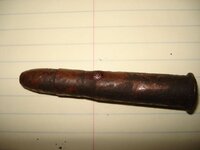teverly
Hero Member
- Mar 4, 2007
- 921
- 16
- Detector(s) used
- MINELAB E TRAC x 2 xp deus
- Primary Interest:
- Metal Detecting
This is a picture of a bullet that i found under a torn up sidewalk and i cant seem to find any info on it.
It says Western and has a - 17 on the bottom.
It says Western and has a - 17 on the bottom.



 If it's over 16" long it's probably anti-tank munitions.
If it's over 16" long it's probably anti-tank munitions. 


